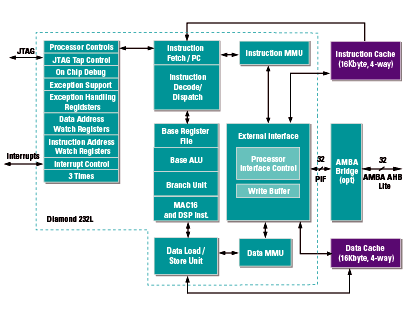“Post-RISC” core gains Linux support
Aug 18, 2008 — by Eric Brown — from the LinuxDevices Archive — 1 viewsTimeSys announced general availability of a LinuxLink subscription for an ultra low-powered “post-RISC” (reduced instruction set computer) processor core from Tensilica. The subscription supports Tensilica's Diamond Standard 232L, touted as out-performing ARM9, while being the “lowest-powered licensable 32-bit core that supports Linux.”
The

Tensilica Diamond Standard 232L architecture
Announced in early June, TimeSys's Tensilica LinuxLink subscription provides an embedded Linux platform that has been integrated and tested for the 232L core, says Timesys. No support for specific system-on-chip processors using the 232L core was promised, however.
The Tensilica LinuxLink is based on a 2.6.25 kernel. It includes 232L-specific device drivers, GNU uClibc based toolchain, and hundreds of pre-built packages. Subscribers also have access to the Timesys TimeStorm development environment and ongoing support, says the company.
In the June announcement, Timesys also said it planned to support Tensilica's Xtensa 7 core, which targets deeply embedded applications, such as embedded control and digital signal processing. It also uses the Xtensa architecture.
Stated Greg Quiggle, VP of Marketing for Timesys, “Tensilica processors offer developers a great deal of flexibility when optimizing a design for system-level performance.”
Embedded Alley (EA) has also announced support for the two Xtensa chips. The professional services and consulting firm plans to produce a “Platform Optimized Linux Solution” (POLS) for the processor, described as a customized embedded Linux development and runtime environment.
Availability
The LinuxLink subscription for the Diamond Standard 232L is available today, says Timesys. More information may be found here.
This article was originally published on LinuxDevices.com and has been donated to the open source community by QuinStreet Inc. Please visit LinuxToday.com for up-to-date news and articles about Linux and open source.